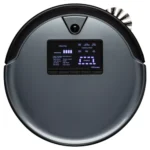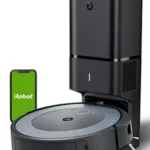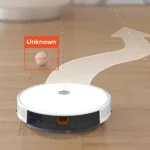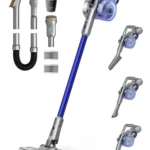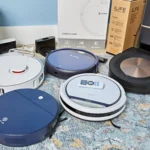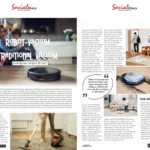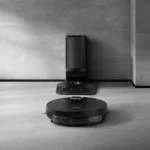As we continue to prioritize hygiene now more than ever, the demand for advanced cleaning technologies is rapidly increasing. Smart vacuum cleaners have become a staple in many households, offering convenience and efficient cleaning. However, some models now also come equipped with UV sterilization technology. This leaves us wondering, how does UV Sterilization in Smart Vacuum Cleaners Work? Let’s delve into the basics of UV sterilization and explore its applications in smart vacuums, as well as its potential future advancements.
The Basics of UV Sterilization
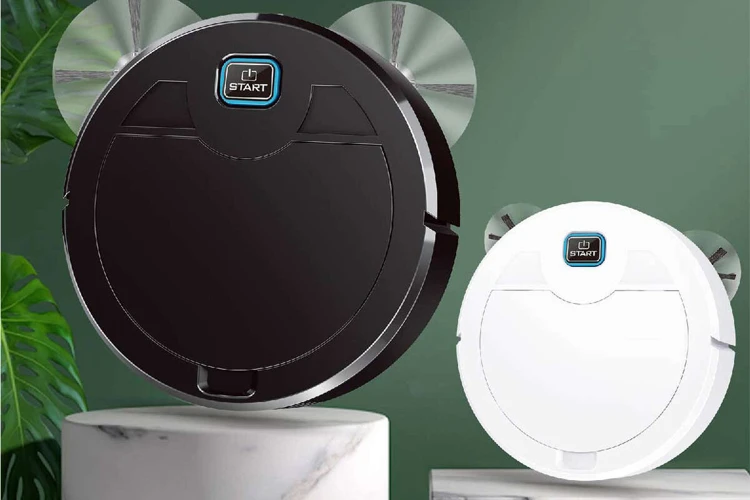
As technology advances, more and more households are turning to smart vacuum cleaners to keep their homes clean. One of the most important features that make these devices stand out is UV sterilization. Using ultraviolet light, these vacuums are capable of eliminating bacteria and germs in a way that traditional cleaning methods can’t. This technology is incredibly effective, but how exactly does it work? In this section, we’ll explore the basics of UV sterilization and why it has become a must-have feature in modern smart vacuum cleaners. To learn more about the benefits of using UV sterilization in smart vacuums, check out our guide here.
What is UV Light?
UV light is a type of electromagnetic radiation that is invisible to the naked eye. It’s a part of the spectrum of light that has a shorter wavelength than visible light, making it highly energetic. The sun is a natural source of UV light, and exposure to it can cause tanning and sunburns. However, scientists have harnessed the power of UV light for many practical applications. Some common applications of UV light include:
- Water Purification: UV light can kill germs and bacteria in water, making it safe to drink.
- Air Purification: UV light can be used to sterilize the air in hospitals, laboratories, and other settings where clean air is critical.
- Surface Sterilization: UV light can be used to sterilize surfaces, such as surgical instruments and food packaging.
- Insect Control: UV light can be used to attract and kill insects, such as mosquitoes.
In recent years, a new application for UV light has emerged – UV sterilization in smart vacuum cleaners. This technology uses UV light to kill germs and bacteria on the surfaces it comes into contact with.
To learn more about how UV sterilization compares to vacuuming alone, check out our article on UV Sterilization vs Vacuuming. And for information on the health benefits of UV sterilization in smart vacuum cleaners, be sure to read our guide to the health benefits of UV sterilization in smart vacuum cleaners.
How Does UV Sterilization Work?
UV sterilization operates by utilizing ultraviolet light to destroy the DNA or RNA molecules that exist in viruses, bacteria, and other forms of microorganisms. The UV light falls within the electromagnetic spectrum’s short wavelength that lies between 200 and 400 nanometers (nm). When microorganisms are subjected to greater doses of UV irradiation, their genetic material connected with DNA or RNA is disturbed, rendering it cross-linked, which prevents it from replicating or inflicting disease.
UV Sterilization utilizes two different wavelengths: UV-C at 253.7 nm and UV-B at 306 nm. Of these, UV-C is the most efficient because it contains the highest photon energy. When UV-C photons penetrate through bacterial cell walls, they degrade and absorb nucleic acids found in RNA and DNA. They generally disrupt and destroy the cell’s DNA, which aids in the prevention of reproduction and destruction of viruses and bacteria.
The UV-C lamps in smart vacuum cleaners are located next to the suctioning mechanism or in the dust storage bin. They turn on automatically when the vacuum is in the UV sterilization cycle. After collection, the dustbin is opened and UV light is bathed on it. Carrying out this step will kill any germs or bacteria present in the dustbin.
A typical UV sterilisation cycle lasts between 30-40 minutes, depending on the smart vacuum cleaner manufacturer. Some smart vacuums will require the user to prompt this cycle while others have an automated process that commences as soon as the vacuum is turned off.
UV sterilization technology is exceptionally efficient at eliminating virtually all germs considering its high level of efficacy, ease of use, and Eco-friendliness. That being said, it still has limitations, which is why it is essential to recognise other technologies sometimes combined with UV sterilization to achieve the desired result.
Why is UV Sterilization Effective?
UV sterilization is an effective cleaning technology because of its ability to kill bacteria, viruses, and other microorganisms by disrupting their DNA structure. This is accomplished through the emission of UV-C light, which has a wavelength of 254 nanometers and is highly effective at destroying microorganisms. Here are some reasons why UV sterilization is an effective cleaning method:
- Chemical-Free: Unlike traditional cleaning agents that rely on chemicals to destroy microorganisms, UV sterilization is a chemical-free cleaning method. This means that it is safe for use around children and pets, and it doesn’t leave any harmful residue behind.
- Wide-Spread: UV sterilization can be used on a wide range of surfaces, making it a versatile cleaning method. UV sterilization can be used to clean anything from floors and carpets to countertops and furniture.
- Fast and Effective: UV sterilization is a fast and effective cleaning method. It only takes a few seconds for the UV-C light to kill the microorganisms, and it doesn’t leave any mess behind like traditional cleaning agents.
- Proven Method: UV sterilization has been used in hospitals and food processing facilities for years because of its proven effectiveness at destroying microorganisms.
UV sterilization is an effective cleaning method because it is chemical-free, can be used on a wide range of surfaces, is fast and effective and has been proven to work in high-risk environments. As we move into the future of home cleaning, it’s likely that UV sterilization will continue to play a larger role in our cleaning routines. To learn more about how UV sterilization can be used in smart vacuums, check out our comprehensive guide.
Applications in Smart Vacuum Cleaners
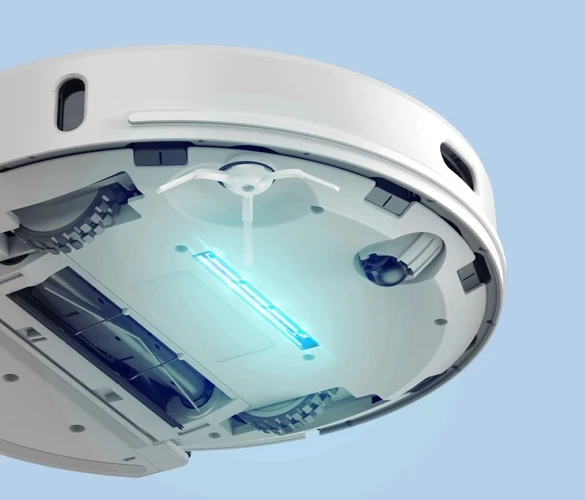
As we continue to look at UV sterilization technology, we’ll now explore how it is incorporated into smart vacuum cleaners. Smart vacuums have become a game-changer in the home cleaning industry thanks to their advanced features and functionality, and UV sterilization is just one of the ways they stand out from traditional vacuums. In this section, we’ll dive into the specific applications of UV sterilization in smart vacuums and explore the benefits and limitations of this technology. We’ll also take a sneak peek into the future of home cleaning with UV sterilization and what other exciting technologies are emerging. So let’s hit the ground running and find out how smart vacuums use UV sterilization to enhance the cleaning process.
How Do Smart Vacuums Use UV Sterilization?
Smart vacuums revolutionize the way we clean our homes, and UV sterilization is one of the latest technologies they utilize. Here’s how smart vacuums use UV sterilization to help maintain a clean home:
1. UV Light – UV lights are integrated into smart vacuums to sanitize and disinfect surfaces by emitting short-wavelength ultraviolet light.
2. Targeted cleaning – Smart vacuums use sensors and cameras to navigate and map the house, which allows them to provide targeted cleaning where needed. Additionally, the UV light technology ensures that any bacteria, viruses or other harmful organisms are not left behind.
3. Automatic activation – The UV sterilization function of smart vacuums is activated automatically once the vacuum detects that a surface needs sterilizing. This means the user doesn’t have to think about how often or where to use the feature since the vacuum takes care of it.
4. Debris removal – While the UV light kills any bacteria or viruses, vacuuming is still needed to remove any dirt and debris that may be on the surface. Smart vacuums use suction power combined with a rotating brush to pick up dirt and debris while the UV light takes care of sterilizing surfaces.
UV sterilization in smart vacuums is an innovative and effective way of keeping a clean home. By combining the latest technologies, smart vacuums provide a better cleaning experience and a healthier living environment.
Check to see how UV sterilization can help you maintain a clean home with a smart vacuum cleaner.
What Are the Benefits of UV Sterilization in Smart Vacuums?
Using UV sterilization in smart vacuums offers numerous benefits that can greatly improve the cleanliness and hygiene of your living space. These benefits include:
1. Effective Elimination of Germs and Microorganisms: UV sterilization technology is highly effective in eliminating germs, bacteria, viruses, and other microorganisms that live on surfaces such as floors, carpets, and sofas. By using a smart vacuum with UV sterilization technology, you can be sure that the floors and other surfaces in your home are free from harmful pathogens.
2. Elimination of Unpleasant Odors: Microorganisms and bacteria can produce unpleasant odors that can be difficult to get rid of. By using a smart vacuum cleaner with UV sterilization, you can eliminate these unpleasant odors quickly and easily.
3. Time and Energy Efficiency: Smart vacuums with UV sterilization technology are designed to save your time and energy by providing a comprehensive cleaning solution in a single device. With the UV sterilization feature, you can forget about having to sweep, vacuum, and disinfect your floors separately.
4. Improved Indoor Air Quality: UV sterilization helps to lower the number of harmful airborne particles in your home that can cause allergies, asthma, and other respiratory conditions. By using a smart vacuum with UV sterilization technology, you can enjoy better indoor air quality and reduce your chances of contracting various respiratory illnesses.
5. Cost-Effective Cleaning: Although smart vacuums equipped with UV sterilization technology may seem expensive initially, they can save you a lot of money in the long run. By eliminating the need for separate cleaning devices, you can lower your cleaning expenses while still achieving a high level of cleanliness and hygiene in your home.
Using smart vacuum cleaners with UV sterilization technology is a smart choice for anyone who wants to achieve a high level of cleanliness and hygiene in their home. By investing in one of these devices, you can enjoy numerous benefits such as efficient cleaning, improved indoor air quality, the elimination of unpleasant odors, and much more. Discover the future of cleaning with smart vacuums and UV sterilization technology by clicking this link: /future-cleaning-uv-vacuums/.
What Are the Limitations of UV Sterilization in Smart Vacuums?
While UV sterilization in smart vacuums offers a promising solution for keeping homes healthier by eliminating harmful bacteria and viruses, there are some limitations to this technology to keep in mind. Here are a few points to consider:
- Not all germs are vulnerable to UV light. While UV-C light is effective against many bacteria and viruses, it may not eliminate all types of germs, such as mold or spores. It is important to continue regular cleaning practices in addition to using a smart vacuum with UV sterilization.
- UV sterilization requires direct exposure to the light. In order for UV-C light to be effective, it must shine directly on the surface being disinfected. This means that areas that are difficult to reach or hidden under furniture may not receive adequate sterilization.
- UV-C light can be harmful to humans and pets. While UV-C light is safe to use when handled properly, direct exposure to bare skin or eyes can cause damage such as skin burns or eye injuries. It is important to turn off the UV sterilization function when people or pets are present in the room.
- UV-C bulbs need to be replaced regularly. Over time, the UV-C bulbs in smart vacuums will lose their effectiveness and need to be replaced to maintain optimal performance. This can be an additional cost and maintenance task for homeowners to consider.
While these limitations may seem daunting, it is important to remember that UV sterilization in smart vacuums is still a valuable tool for home cleaning. By incorporating UV-C light into their cleaning routines, homeowners can take an important step towards reducing the presence of harmful germs in their homes.
The Future of Home Cleaning
As technology continues to advance, so does the future of home cleaning. From manual mopping and sweeping, to the introduction of robotic vacuum cleaners, cleaning our homes has never been easier. However, the future of home cleaning is not just about automation, but also about improving the cleanliness of our living spaces. One technology that may hold the key to a truly sterilized home is UV sterilization. With recent advancements in this technology, we can expect to see smarter and more efficient devices that make our homes cleaner and safer than ever before. Let’s explore the exciting possibilities that lie ahead.
What Advances are Underway in UV Sterilization Technology?
UV sterilization technology has come a long way since its inception, and new advances are being made all the time to make it even more effective. Here are some recent developments that are worth noting:
| Advance | Description |
|---|---|
| Increased Power | With more powerful UV-C LEDs available, sterilization units can be made smaller and more efficient without sacrificing effectiveness. |
| Multi-Wavelength UV-C | While UV-C light is already highly effective at killing viruses and bacteria, research has shown that using multiple wavelengths can be even more effective. |
| Pulsing UV-C | By pulsing UV-C light, rather than using a continuous stream, the energy can be directed to specific areas while minimizing the risk of UV exposure to humans. |
| Vacuum-Cleaning Integration | New smart vacuums are being designed with integrated UV-C sterilization units, making the cleaning process even more efficient and effective. |
| UV-C Robots | Some companies are developing robots that use UV-C light to disinfect surfaces autonomously, reducing the need for human cleaners in high-risk areas. |
These advances in UV sterilization technology are exciting, and they are sure to lead to even more effective and efficient cleaning methods in the years to come. As researchers continue to explore the possibilities of this technology, it’s likely that we’ll see even more breakthroughs that will revolutionize the way we keep our homes and workplaces clean and safe.
How Will Future Smart Vacuums Use UV Sterilization?
As technology advances, it is becoming increasingly clear that smart vacuums will play an even bigger role in our homes. The future of smart vacuums is bright as they continue to incorporate new features that make cleaning tasks even easier. One of the most important features that future smart vacuums will undoubtedly have is UV sterilization.
The Future of Smart Vacuums:
UV sterilization technology in smart vacuums is already making waves in the cleaning industry. In the near future, it will become a standard feature in most smart vacuums. This technology works by using UV-C light to destroy bacteria, viruses, and mold spores, among other harmful pathogens.
| Future Smart Vacuum Features: | How UV Sterilization Will be Used: |
| Smart Navigation | UV Sterilization will be used to sterilize all surfaces in the home, removing the need for manual cleaning altogether. |
| Multi-Room Mapping | Smart vacuums will use UV sterilization to disinfect surfaces in different rooms within the home, ensuring that every surface is clean and germ-free. |
| Voice-activated Control | UV Sterilization will be activated via voice commands, making it even easier to use and control the smart vacuum. |
| Complete Automation | UV Sterilization will become a core component of smart vacuums, allowing them to operate autonomously, making cleaning effortless for homeowners. |
| Improved Battery Life | In the future, smart vacuums will have longer battery life, enabling them to clean and sterilize homes more efficiently. |
The Benefits of UV Sterilization in Smart Vacuums:
Future smart vacuums that incorporate UV sterilization technology will have numerous benefits for homeowners. These benefits include:
- Complete disinfection of all surfaces in the home, reducing the risk of illness and disease.
- Reduced need for manual cleaning, saving time and energy.
- Improved air quality by removing dust, bacteria, and allergens from the home.
The Future of Home Cleaning:
The future of home cleaning is all about automation and disinfection. Smart vacuums that incorporate UV sterilization technology will be at the forefront of this trend, providing effortless cleaning and disinfection for homeowners. Additionally, there are other emerging technologies such as robotic mops, air purifiers, and smart home systems that work in conjunction with UV sterilization to make homes cleaner and safer. With these advances, the future of home cleaning is looking brighter than ever.
What Other Technologies are Emerging to Compliment UV Sterilization?
As we look to the future of home cleaning, it’s clear that UV sterilization will continue to play an important role. However, there are also other emerging technologies that can complement UV sterilization and make cleaning even more effective.
One such technology is HEPA filtration. HEPA, or High Efficiency Particulate Air, filtration is a type of filter that can trap even the tiniest of particles, such as pollen, pet dander, and dust mites. When used in conjunction with UV sterilization, HEPA filters can help remove both biological and non-biological contaminants from your home.
Another emerging technology that can complement UV sterilization is robotic vacuum cleaners. These advanced devices are designed to autonomously navigate your home and clean your floors. Some models even come equipped with UV sterilization capabilities, which allow them to kill germs and bacteria as they vacuum.
Additionally, artificial intelligence (AI) and machine learning are becoming more prevalent in the world of home cleaning. AI-powered smart vacuum cleaners can learn your home’s layout and cleaning patterns, allowing them to better navigate around obstacles and clean more efficiently. They can also be programmed to automatically activate and deactivate UV sterilization based on your cleaning preferences.
Finally, self-cleaning technology is also an emerging innovation that could complement UV sterilization. Some smart vacuum cleaners come equipped with a self-cleaning feature that uses UV-C light to sterilize the device’s brushes and filters, helping to prevent the spread of germs and bacteria between cleaning sessions.
As these technologies continue to evolve and become more widespread, it’s likely that future smart vacuum cleaners will incorporate a combination of UV sterilization, HEPA filtration, robotic navigation, AI, and self-cleaning features. This could lead to a revolution in home cleaning, making it easier and more effective than ever before.
| Technology | Description |
|---|---|
| HEPA filtration | A type of filter that can trap even the tiniest of particles, such as pollen, pet dander, and dust mites. |
| Robotic vacuum cleaners | Autonomously navigates your home and clean your floors. Some models even come equipped with UV sterilization capabilities. |
| Artificial intelligence (AI) | Allows vacuum cleaners to learn your home’s layout and cleaning patterns, better navigating around obstacles and cleaning more efficiently. |
| Machine learning | Allows smart vacuum cleaners to adjust cleaning patterns and automatically activate and deactivate UV sterilization based on your cleaning preferences. |
| Self-cleaning | Uses UV-C light to sterilize device’s brushes and filters, helping to prevent the spread of germs and bacteria between cleaning sessions. |
Conclusion
In conclusion, UV sterilization is an innovative technology that has revolutionized the way we clean our homes. It is a powerful tool that can effectively eliminate harmful bacteria, viruses, and pathogens that accumulate in our living spaces. With the integration of UV sterilization in smart vacuum cleaners, cleaning has become more efficient and effective.
Through this article, we have learned that UV sterilization works by using the short wavelengths of UV-C light to destroy microorganisms by disrupting their DNA structure, rendering them inactive and unable to reproduce. And because UV sterilization does not rely on chemicals or heat, it is a safe and eco-friendly option for home cleaning.
Smart vacuum cleaners with UV sterilization features are an excellent addition to any home cleaning arsenal. They can effectively clean and disinfect hard-to-reach areas and other surfaces that conventional cleaning methods cannot reach. The benefits of using smart vacuums with UV sterilization technology include improved air quality, reduced risk of infection, and a healthier living environment for everyone at home.
While there may be limitations to using UV sterilization in smart vacuums, such as its inability to kill spores and other resistant microorganisms, its potential for home cleaning is tremendous. Now, with the continuous advancements in technology, the future of home cleaning is looking bright, with the emergence of new complementary technologies that can work together with UV sterilization to create a more efficient cleaning process.
As we continue to prioritize cleanliness and hygiene in our homes, we can expect to see more smart vacuums using UV sterilization technology in the future. And as we explore more innovative ways to keep our homes clean, we can be sure that there will always be a need for effective and safe cleaning solutions like UV sterilization.
Frequently Asked Questions
What is the difference between UV sterilization and HEPA filtration?
UV sterilization uses ultraviolet light to kill bacteria and viruses, while HEPA filters trap particles such as dust and allergens.
How long does it take for UV sterilization in smart vacuums to work?
The amount of time it takes for UV sterilization to work varies depending on the intensity of the UV light and the size of the space being treated. Generally, it takes a few minutes for the UV light to kill bacteria and viruses.
Do UV sterilization bulbs need to be replaced?
Yes, UV sterilization bulbs have a limited lifespan and need to be replaced periodically in order to maintain their effectiveness.
Can UV sterilization in smart vacuums be harmful to humans or pets?
UV sterilization is generally safe for humans and pets at the levels used in smart vacuum cleaners. However, it can be harmful to the eyes and skin if someone is exposed to high levels of UV light for a prolonged period of time.
Can UV sterilization in smart vacuums disinfect carpets and upholstery?
Yes, UV sterilization can disinfect carpets and upholstery, but it may not be as effective as other methods such as steam cleaning or chemical disinfectants.
Do smart vacuums with UV sterilization replace the need for manual cleaning?
No, smart vacuums with UV sterilization should be used as a supplement to manual cleaning. They can help kill bacteria and viruses in between cleanings, but they cannot completely replace the need for manual cleaning.
Is UV sterilization in smart vacuums effective against COVID-19?
While UV sterilization can be effective against some viruses, including coronaviruses, it is not yet clear whether it is effective against COVID-19 specifically.
Can UV sterilization in smart vacuums be used in commercial settings?
Yes, UV sterilization can be used in commercial settings, but it may need to be used in conjunction with other cleaning methods to be fully effective.
How do you clean the UV sterilization bulb in a smart vacuum?
The UV sterilization bulb should be cleaned with a soft, dry cloth. Do not use water or cleaning solutions, as this can damage the bulb.
Can UV sterilization in smart vacuums be turned off if desired?
Yes, most smart vacuums with UV sterilization have the option to turn off the UV light if desired.

